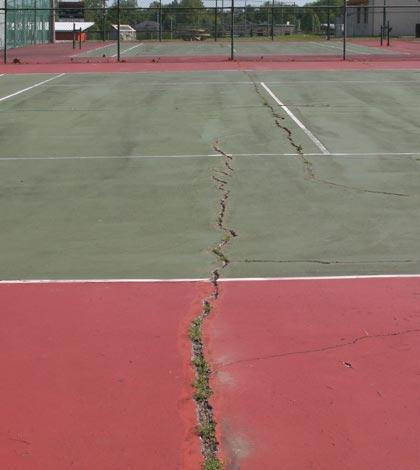Tennis court closing causes stir

Pictured are the old WHS tennis courts at the intersection of Hamacher and Rogers streets, which closed to the public last week. (Sean McGowan photo)
For about 30 years, the Larry Henson tennis courts in Waterloo have provided the community a place to blow off steam and for tennis players to work on their backhand.
They serve as a summertime hot spot, a stomping grounds for Waterloo High School tennis alumni and a reminder of one coach’s legacy. But Henson, a WHS sports hall of fame legend, seems less concerned with his name being known and more concerned with what closing the courts would symbolize.
“I don’t want this to be about me,” the former 30-year WHS tennis coach stressed upon finding out the courts had recently been closed.
Henson echoed the sentiments many expressed on Facebook when he said closing the courts would devastate Waterloo.
“I feel it would be a sad day in the community if there were no tennis courts and, on top of that, no public pool,” he said, referring to the 2012 closure of the Sondag city pool.
Henson said the courts at the corner of Rogers Street and Hamacher Street were built in the mid-1970s. The WHS tennis team used these courts until 2009, when the new high school, and subsequent new tennis courts, came together.
The old courts saw a lot of use until the school district locked them up last week, including from the Gibault Catholic High School tennis team that used them for home games up until a couple of years ago.
“I saw people there often. On a nice day, there were people out there playing tennis,” Waterloo school superintendent Brian Charron said.
Safety concerns
Unfortunately, major cracks and changes in elevation on the courts constitute safety concerns and allegedly caused at least one person to be injured. This has led the school board to close the courts until coming to a decision on whether to make the necessary repairs.
In 2015, the issue of the tennis courts first appeared at a school board meeting when the estimated cost for sealing the cracks came out to $10,000 and resurfacing estimates totaled $90,000.
“I don’t know why they don’t just patch up the cracks like they used to,” Henson questioned.
But, as Charron explained, the board does not wish to spend $10,000 every year to re-seal these cracks when a more long-term solution is available. The board opted for more time to weigh the costs at the 2015 meeting rather than make a decision so early in the game.
Charron said as time went on, there was a change in elevation at the cracks. Additionally, the court surface had “settled,” meaning even resurfacing would not solve the problem.
“We were told that it would be a waste of money to repair the courts if we’re not re-doing the foundation underneath,” Charron elaborated.
Re-doing the foundation would add $200,000 to $400,000 to the estimated cost when also considering that the fences would need to be torn down — and replaced with new fencing due to general wear — to make room for equipment needed for the job.
“At that, the board became very hesitant to make that expensive of an investment for tennis courts that our schools wouldn’t use,” he said.
The board demonstrated its hesitation in March when a motion was made to table approval of a construction company’s design proposal for remodeling the courts. At that time, Waterloo School Board president Johnny Caupert said the board could also make the decision to remove the courts entirely but wanted more time to weigh options.
Injury fall lawsuit
Prior to that, Margaret May, former Gibault tennis coach, filed a lawsuit against the district for an injury fall suffered on one of the courts in 2015 during a team practice.
May “voluntarily dismissed” the lawsuit in February per court records, a measure that was subsequently approved by the school district and court.
“It had something to do with the attorney,” May explained of why she dismissed the lawsuit.
St. Louis attorney Brian Stokes had taken on May’s case, but withdrew in only a month’s time at her request. She said she did not seek another attorney to continue pursuing the lawsuit.
Following her fall, May elaborated that she underwent two surgeries and suffered irreparable damage to her thumb.
“I’ve played tennis for 50 years, and I’ll never play again. It could’ve been helped because I had been telling them for two years to do something with those courts,” she lamented.
No simple solution
One way to pay for the tennis courts is to use school facility sales tax revenue. While some of that is going toward summer facility projects, there would be enough remaining for the courts, Charron confirmed.
But board members said they would prefer not to use money they feel should instead go toward benefitting students. Additionally, Charron said some board members have suggested the public share in the cost of maintaining the courts.
“I truly think the board is torn on what to do,” he added. “Spending sales tax dollars is an option, but the board is cognizant that it’s not being used for the student body. And I think that has caused there to be reservations.”
In support of Charron’s statement, Caupert addressed on Facebook that the board would appreciate any public input during its May 15 meeting.
“I believe I speak for the entire board when I say that we want to hear from the community before a decision of any kind is made,” he said.
Caupert further explained that those interested in speaking at the meeting must contact the school district no later than Wednesday to be added to the agenda. While Charron confirmed that two people have been tentatively scheduled to address the board, the topic will not be a board discussion item.
Alternative facilities
Charron noted that the WHS courts will not be available for public use when the school is hosting IHSA competitions. The board can decide whether to make them available to the public during the off-season, but Charron said he does not foresee that.
“Unsupervised access results in damage (to the facilities). Kids in the community will hang on the net,” Charron said as an example of the harm public access could cause.
For residents interested in using other school district facilities, Charron referred to the district’s facilities use plan that stipulates people can rent certain facilities during non-school hours. Charron said the Waterloo Junior High outdoor track is the only available facility that does not require renting.
Outside of Waterloo, anyone can use the four tennis courts located at Bolm-Schuhkraft Park or the singular tennis court at Metter Park, both in Columbia. Only Columbia residents are able to reserve the courts, making them first come, first served for non-residents.






